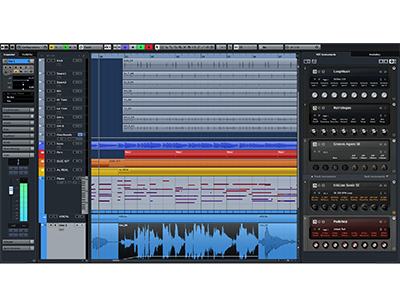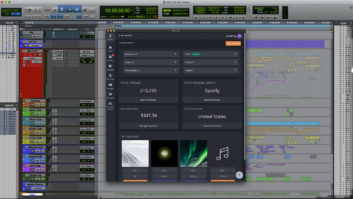
Which DAW is right for me? Updates, revisions, whole makeovers—is it time to jump? Steinberg has released the latest version of its acclaimed Cubase software, and there is certainly a lot to talk about. Let’s take a look and see if Cubase Pro 8 is worth the upgrade, and if it’s the DAW for you.
Right off the bat, Pro 8 is the first version of Cubase that allows complete independent docking and undocking of windows. Although you no longer need to stretch your main application across multiple screens, you now have a secondary window that unfortunately does not have minimize or maximize functionality. Although transparent (which conveniently lets you view your desktop underneath), there is no ability to access items beneath this window without bluntly dragging it around your desktop.
Another new feature is the Rack Zone, a large vertical sub-window to the right of your Project window that combines MediaBay and the VST Instrument Rack. While this is a convenient option, having a large static bar to the right of your track window may not be the layout you prefer. It would be better to be able to remove this permanently if so desired, versus undocking it or using the alt+T command.
The first of the new features that relates to performance is the redesign of ASIO-Guard latency engine (now ASIO Guard 2). As a direct improvement to the resource handling of your DAW, ASIO Guard 2 supports disk streaming instrument tracks, as well. The engine intelligently monitors your tracks, allocating resources where latency matters the most. This allows real-time monitoring on heavy projects without pops and clicks.
Another happy boost for performance is the new “render-in-place” function, which is a great way to swap your MIDI to audio without a cumbersome channel batch export.
The long-heralded Quadrafuzz has bowed on the plug-in stage in version 2, bringing warm, fuzzy, fat harmonic tones aplenty—this distortion plug-in is awesome. From a simple interface, it provides a surprisingly dynamic range of tones. It would honestly be hard not to find a sound you like.
Multiband Compressor and DeEsser were both blessed with a sidechain feature. Expander and Envelope Shaper boast new multiband options, and DeEsser was also added as a channel-strip module. The Tuner plug-in was given a strobe mode and a larger window for improved visibility.
In addition to plug-ins, Steinberg has added some new content. Groove Agent SE 4 has drafted Acoustic Agent to the lineup of sounds, which is an acoustic set full of natural, organic-sounding drum samples. Allen Morgan Pop-Rock Toolbox is another new set of 30 construction kits, each with an abundant set of predefined audio loops.
It would appear that many of the Cubase 8 improvements are designed to help keep the creative juices flowing. The new Circle of 5ths and Proximity Chord Assistant modes provide visual assistance in making progression choices. Proximity Chord Assistant analyzes a defined reference chord, and visually displays relevant suggestions. These suggestions are then displayed within a standard Circle of 5ths relevant to the key you are working in. These modes tie directly into your chord pads, making composition a much easier task, particularly for those who aren’t quite as musically inclined. I was surprised at how simple it was to start creating a track.
While dabbling with this new content, I took the new MIDI tempo detection for a test run. I found this new feature particularly useful when creating a piano track. I love to play piano, but am not necessarily a disciplined player, and when I play to a metronome, I tend to stiffen up. MIDI tempo detection allowed me to play freely, auto-detecting my tempo and making it easier to quantize post-performance by automatically lining my notes up with the grid.
One last addition is Virtual Bass Amp. Similar to the VST Rack for guitar, Virtual Bass Amp boasts a collection of amps and cabinets, microphone positions and stomp boxes that make for a nice plug-in.
Cubase 8 introduces Waves Meters to MixConsole, a feature also found in Cubase’s big brother Nuendo. Waves Meters shows each track’s waveform vertically above the appropriate mixer channel. The waveform scrolls in time so you can see what position in the song you are without having to switch views. On the downside, MixConsole can no longer be viewed in full-screen mode, which definitely affects the convenience of this add-on.
A few other tweaks to MixConsole are an improved channel-strip EQ and the addition of VCA faders. The improved EQ allows frequencies to be identified with their corresponding pitch note, which can be very useful in avoiding frequency conflicts. High-cut and low-cut filters on Pre also now have selectable slopes ranging from 6 dB to 48 dB per octave. VCA faders are not unlike the Link feature from 7.5, which allowed you to group and link channels. However, VCA functionality resolves prevents the gain structure of the linked channels from affecting the gain structure of effects sends, which was a major dilemma when linking channels in previous versions.
I reviewed 7.0 in March 2013, so I put up Cubase 8 to see how it measured up. As a baseline test, I referenced a score I had composed within Cubase 7.5 and charted performance levels.
Performance: CPU and Disk handling improvements were, on average, 8 percent to 12 percent better in Cubase 8, which provided enough headroom to dial back my hardware latency buffer from 1,024 to 512. ASIO Guard 2 isn’t just a marketing spin; it definitely improves overall performance.
Workflow: The transition between Cubase versions on the same project was seamless, as was basic integration. Cubase’s GUI has always been very conducive to an ergonomic workflow, but there are changes that took some getting used to. The addition of Rack Zone to the main project window, floating windows and the addition of Waves Meters to MixConsole would indicate a scenario where an end user has multidisplay real estate available for viewing. This is not always the case, and the fact that MixConsole can no longer go full screen seems counterintuitive.
Although there are some minor aesthetic and functionality flaws to be found in this latest revision of Cubase, there are far more compelling new features within Cubase 8 than qualms. Any DAW is not without its flaws, but the core competencies that Cubase is known for—performance, stability and versatility—remain intact and have been improved. The new content and improved audio engine alone make it worth the upgrade/purchase. However, I do hold Cubase to a very high standard, and being completely candid, on a scale of 1-10, I would give Cubase 8 an 8.
Jami McGraw is a NY-based engineer, musician and IT pro.







